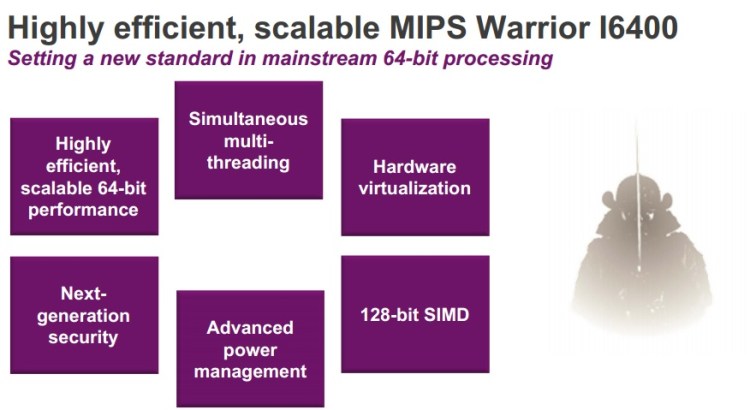We’ve heard a lot about the coming clash between ARM-based chips and Intel x86 processors in data center servers. But the MIPS architecture doesn’t want to be left out of that battle.
Imagination Technologies is announcing today a 64-bit MIPS Warrior core design for chips that can be used in everything from mobile devices to data center servers. The MIPS I-class I6400 central processing unit (CPU) family represents Imagination’s bid to make the MIPS computing architecture relevant in the modern age.
While ARM has dominated smartphones and tablets and Intel’s x86 has occupied the PC market, MIPS has been in a middle ground in devices like smart TVs and consumer electronics. With the new Warrior cores (which can be taken by Imagination’s licensees and designed into working chips), Imagination will try to break into new markets: Chips that use the core will be used in the embedded, mobile, digital consumer, advanced communications, networking, and storage markets.
“This is the MIPS Warrior core that many have been waiting for,” said Tony King-Smith, executive vice president of marketing at Imagination, in a statement. “As the industry moves toward instruction set neutrality, customers can now choose a CPU based on its technical superiority. The I6400 is more efficient, flexible, and scalable than the competition, and its feature set clearly lends itself to the needs of a wide range of next-generation applications including smartphones and tablets. We know that unique features like multi-threading provide significant advantages for many applications, and customers already using this technology agree. Unsurprisingly, we’ve already secured licensees for the I6400 across multiple markets.”
The new cores are designed to be highly efficient and scalable. They use a 64-bit architecture, which is a prerequisite in servers, as well as hardware virtualization. The cores also feature multi-threading, multi-core, and multi-cluster coherent processing.
Imagination says that these features will put the I6400 far ahead of the competition, enabling customers to implement a smaller core at the same performance, or a faster core in the same size chip. Imagination says that compared to rivals, it achieve 50 percent higher performance on the CoreMark benchmark and 30 percent higher performance on the DMIPS benchmark.
Jim McGregor, founder and principal analyst at Tirias Research, said, “To address the ongoing evolution in applications from IoT to mobile to networking and storage, companies need to select scalable platforms that can future-proof their designs. With 64-bit, multi-threading, and multicore/multi-cluster support, the I6400 is designed to be a phenomenally flexible, low-power processor architecture capable of scaling across a wide range of applications. Imagination now has MIPS cores for everything from microcontrollers to 64-bit servers, delivering choice across the range and changing the competitive dynamic in the industry.”
Imagination is already talking with multiple lead I6400 licensing partners, with general availability scheduled for December 2014. Mips Computer was founded in 1981 by computing pioneer John Hennessey, now president of Stanford University. The company created its own microprocessor architecture based on the reduced instruction set computing (RISC) design, which sought to simplify computing to its core roots. The RISC designs, which were also adopted by arm, were considered less complex and more efficient than complex instruction set computing (CISC) architecture, such as x86, which was originally developed by Intel.
Mips licensed its RISC technology to other companies such as Silicon Graphics and Sony. Imagination Technologies acquired it in 2012.
VentureBeat's mission is to be a digital town square for technical decision-makers to gain knowledge about transformative enterprise technology and transact. Learn More

